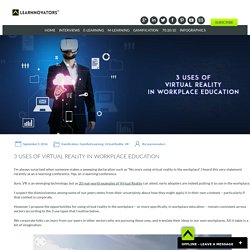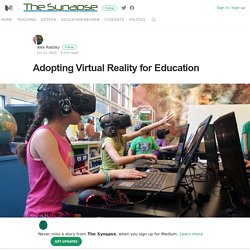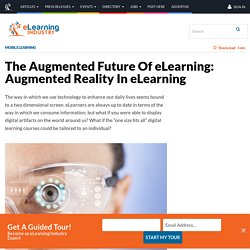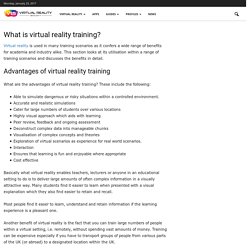

3 Instructional Design Strategies For Virtual Reality Learning - eLearning Industry. 3 USES OF VIRTUAL REALITY IN WORKPLACE EDUCATION - Learnnovators. I’m always surprised when someone makes a sweeping declaration such as “No one’s using virtual reality in the workplace”.

I heard this very statement recently at an e-learning conference. Yep, an e-learning conference. Sure, VR is an emerging technology, but as 20 real-world examples of Virtual Reality can attest, early adopters are indeed putting it to use in the workplace. I suspect the dismissiveness among some of our peers stems from their uncertainty about how they might apply it in their own contexts – particularly if that context is corporate. However, I propose the opportunities for using virtual reality in the workplace – or more specifically, in workplace education – remain consistent across sectors according to the 3 use types that I outline below.
We corporate folks can learn from our peers in other sectors who are pursuing these uses, and translate their ideas in our own workplaces. I don’t know about you, but I don’t see myself visiting any of these places anytime soon. Adopting Virtual Reality for Education - Medium. “As an educator with 20+ years’ experience integrating technology into curriculum, it is exciting for me to see a technology that so quickly captures the attention of the students, motivates them to make the effort to learn the procedures, and then opens them up to the relevant content.“ Larry Fallon, Instructional Technology Coordinator, Arlington County Public Schools You can almost hear the buzz- even above the normal tech chatter about the newest smartphones, tablets, watches, and other wearable devices: virtual reality (along with augmented reality) is coming to consumers in the very near future.

Announcements are coming out almost daily. That virtual reality is going to be a game-changing technology in the years ahead seems to be almost a foregone conclusion, but can it get beyond the gamer led consumer world, and make an impact on education? Why is VR so important now? A low cost headset (made out of cardboard!) The Augmented Future Of eLearning: Augmented Reality In eLearning - eLearning Industry. In this article, you are going to witness the first iteration of a new type of head mounted display that is going to change the way we see the world.

It will fundamentally change the way in which we learn about new subjects, and how we apply that knowledge in our everyday lives. The Microsoft HoloLens is the first product of its kind to change the environment around you. This technology is about to radically change the way in which you learn, and will hopefully revolutionize your perspective in regards to how you examine the world. What is virtual reality training? - Virtual Reality. Virtual reality is used in many training scenarios as it confers a wide range of benefits for academia and industry alike.

This section looks at its utilisation within a range of training scenarios and discusses the benefits in detail. Learning Virtual Reality: Developing Immersive Experiences and Applications for Desktop, Web, and Mobile: 9781491922835: Computer Science Books @ Amazon.com. Benefits And Drawbacks Of Using Virtual Reality In Learning And Development - eLearning Industry. “How does it work?”

, we hear you say. In short, to use virtual reality in Learning and Development, organizations are required to purchase smartphones and virtual reality headsets – ranging from the budget to quite pricey. Responsive content is then created to be used on the smartphones and when employees hold the devices to their faces with the headsets, a unique 3D experience is created to allow them to engage with the eLearning. The theory of virtual reality in eLearning is an exciting one, but before the excitement of new gadgets mists our view of the full educational journey, we are exploring some of the benefits and drawbacks of using virtual reality technology as part of your Learning and Development strategy. How Corporate Learning Is Using Virtual Reality Today. Imagine if a technology came along that allowed your students to transport themselves to any time or place, real or imagined.

Imagine if this technology could be used to create a “flight simulator” for any skill, where students could practice and learn under the same conditions where they will use their skills. And imagine if this technology could also allow students to step into the shoes of a customer or a colleague of different gender, ethnicity, or culture. That technology is here.
It’s virtual reality. The world you experience when you strap on a virtual reality (VR) headset might be virtual, but the learning results are real. The virtual reality learning revolution has already begun. The Tennessee Board of Regents supervises 47 campuses with 173,000 students and has a strategic plan for virtual, augmented, and mixed reality and holograms. The fervor for VR could easily be dismissed if it only came from educational leaders and smaller technology startups. Perhaps not.